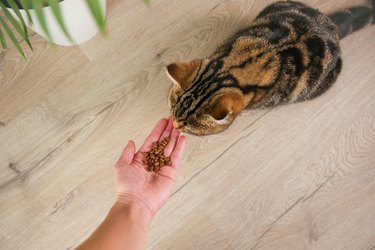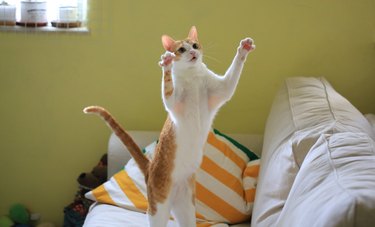If you had to guess whether your cat would choose you over a tasty bite of food, what do you think your feline friend would do? Many people would probably guess that their cat would go for the eats, but according to a recent study, most cats actually preferred the company of humans to their treats. In fact, the cats who participated even choose their human companions over food, toys, and scent.

Video of the Day
What do cats think of humans?
Cats have a bit of an unfair reputation. While dogs are widely considered to be "man's best friend," cats are regarded to be more aloof, at best, if not straight-up moody and dismissive. But what do domesticated felines really think of their caretakers, or of people in general? We know that cats recognize their names when the people they're closest to are saying it, which signifies the bond shared between the two. A 2016 study published in Science Direct conducted by researchers at Oregon State University set out to see just how much cats liked their humans. The study included 25 pet cats, and 25 shelter cats, all aged between 1 and 16 years old.
Video of the Day
In their research, the scientists exposed all 50 cats to four different types of stimuli — human interaction, food, toys, and familiar scents like catnip. What they found was that the majority of cats in either group chose the company of humans over anything else, although the food did come in a very close second.

What do cats want from humans?
So, what is it about human beings that cats enjoy? What do humans provide to felines that could possibly set them ahead of a delicious meal? In this study, the stimuli cats were exposed to in the "human socialization" category included petting, vocalization, and playing with a feather toy attached to a rod, like a cat dancer. Of these three, the majority of cats preferred playing with the human and the feather toy to the other two things. That suggests that cats want to be engaged by humans, and have attention paid to them.
In the food category, the cats were offered tuna, chicken, and chicken-flavored soft cat treats. The scent category contained the smell of a gerbil, which signifies possible prey, catnip, and the scent of an unfamiliar cat. Each of these scents was added to a cotton cloth and offered to the cats. The toys category offered a movement toy, a mouse toy, and a feather toy for the cats to choose from.
Of all of these things, from tuna to other cats to the very toy used by the human participants to play with, most of the cats in this study spent the most amount of time engaging with the people playing with a feather toy. The proof is in the puddling, folks — play with your cats! Learning about enrichment activities for cats can clearly help keep your cat happy, and strengthen your bond.

What does "preferences" mean?
The term "preference" is defined as having a greater liking for one thing over another. In academic and research settings, such as this cat study, preferences are determined by offering the subjects (the cats) a variety of stimuli, or choices, to pick from. In this study, each of the four categories that the cats had to choose from — humans, food, toys, and scent, included three stimuli in each category. This is important for two reasons — one, it eliminated the chance that the cats just happened to like one particular thing within the category, and not necessarily the category itself.
Second, this shows that cats may have the potential to be trained, or work for certain rewards now that more is known about which stimulus they're particularly motivated by and drawn toward. Perhaps it's not that cats are aloof and untrainable; maybe we just haven't been offering them the things they deem worthy of performing for. When compared to dog research, cat research is still quite limited. And even when compared to panda research! Preference tests have been done for tamarins and pandas, but not cats! But studies such as this one make huge advancements in the area of feline understanding, both alone, and in regard to their relationships with human beings.